
The newsletter of UCL Library Services - Issue 26: Autumn term, 2010
Inside this issue
|
|
The latest exhibition from UCL Library Services
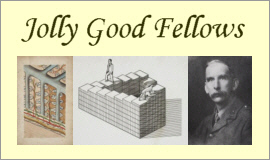
|
|
Editorial board members:
Janet Cropper, Chris Carrington, Anne Chesher, Deborah Furness, Jason Hobart, Nova Larch, Grazia Manzotti, Martine Painter, Ruth Russell & Margaret Stone.
:: Contact the editorial board
|
Welcome to your library
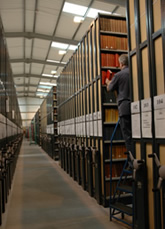 Stores service, Wickford
Stores service, Wickford
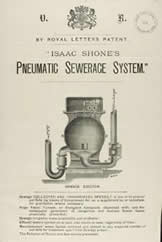
UCL Library Services has 16 libraries with large collections of books and periodicals on open shelves. However, we have a lot of older books and journals in our Store outside London which can be freely requested for delivery to your nearest library within 24 hours. In addition to these paper resources, thousands of journals and a growing number of books are now available in digital format via our web pages for UCL staff and students, and to help you discover what has been published in your subject we subscribe to hundreds of databases which can help save you time and effort with your literature searches.
You can find out more about all these resources by reading the guide that your Subject Librarian has created for your department.
Those of you who are more inclined to historical research will find enormous pleasure in our Special Collections which include personal papers of many past UCL academics, as well as rare books and manuscripts of all kinds.
By Debs Furness
A Cabinet of Curiosities
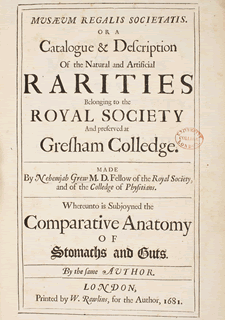 This book is Musæum Regalis Societatis. Or a Catalogue & Description of the Natural and Artificial Rarities belonging to the Royal Society and Preserved at Gresham Colledge. Made by Nehemiah Grew. Printed in London in 1681 it is an exhaustive description of the Royal Society's collections.
This book is Musæum Regalis Societatis. Or a Catalogue & Description of the Natural and Artificial Rarities belonging to the Royal Society and Preserved at Gresham Colledge. Made by Nehemiah Grew. Printed in London in 1681 it is an exhaustive description of the Royal Society's collections.
Collections of specimens of natural history, art, ethnography and so forth have been amassed since ancient times. The word "Museum" originally referred to a building connected with or dedicated to the Muses or the arts inspired by them. Gradually it expanded to mean a building, or part of a building, dedicated to the pursuit of learning or the arts.
In Renaissance Europe it became fashionable for learned gentlemen (and they were nearly always men) to put together collections of their own which were referred to as "Cabinets of Curiosities".
"Cabinet" originally described a room, rather than a piece of furniture. Many were purpose built to hold collections of various kinds. Cabinets might include books, works of art, religious or historical relics, and ethnographic objects. Natural history Cabinets were especially popular and could include a herbarium, preserved and stuffed animals, skeletons, horns and tusks, shells, corals, birds' nests and eggs, stones and metals. Many also included monsters and freaks as well as mythical creatures such as mermaids and unicorns. 1
These cabinets served a useful scientific purpose. They encouraged the study of a wide range of specimens and collectors wrote about their collections, corresponded with one another, visited one another and exchanged specimens. Several private cabinets went on to form the foundations of great museums, for instance the Ashmolean Museum, in Oxford, was founded upon the Cabinet of Elias Ashmole.
2
When the Royal Society was founded in 1660 it was natural that the Fellows would begin a collection of their own. In 1667 Thomas Sprat wrote that the Society was working towards "a General Collection of all the Effects of Arts, and the Common, or Monstrous Works of Nature", and that the Fellows had already "drawn together into one Room, the greatest part of all the several kinds of things, that are scatter'd throughout the Universe." This collection became known as the "Repository" and reflected the Society's interest in every area of natural philosophy and human activity. It included scientific instruments which could be borrowed by the Fellows. The objects donated to the Repository were kept first in Robert Hooke's rooms at Gresham College, where the Society held their earliest meetings, and later in a purpose-built room at the Society's new home in Crane Court. The Repository was not generally open to the public but distinguished visiting scholars were given tours.
The Repository was not confined to science alone but also included historical and archaeological artefacts. As explorers opened up new territories objects came in from all over the known world.
In 1681 Nehemiah Grew published a catalogue of the Repository. The catalogue described each object in detail and attempted to define them in an ordered way, comparing them with similar items in other contemporary museum catalogues and noting differences. Grew's catalogue advertised the Society's Repository to foreign natural philosophers, and sparked new interest in the Society's work.
Grew was a medical doctor who became interested in plant physiology and his book on the Anatomy of vegetables (1671) brought him to the attention of the Royal Society. He was elected a Fellow in November 1671. He published other works and in 1677 was appointed joint Secretary to the Society, with Robert Hooke. He began to catalogue the Repository in 1678.
The Catalogue is divided into four parts:
- Of Animals;
- Of Plants;
- Of Minerals;
- Of Artificial Matters.
Each part was then subdivided, and each item meticulously described.
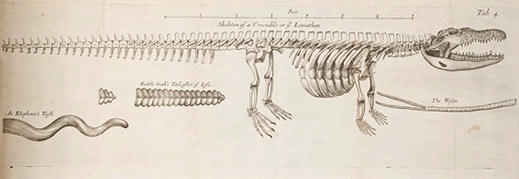
The plate seen above is the skeleton of "a Crocodile or ye Leviathan". 3 This is described in Part I, Section 2, Of Quadrupeds, Chapter 3, Of Oviparous Quadrupeds.
"A Crocodile, about two yards and ½ long. He differs not much from a Lizard; chiefly in his Bulk, and the hardness of his Skin, which on his Back hath Scales proportionably hard and thick. … The same Animal which in the Book of Job is called the Leviathan, and hath been commonly taken to be the Whale; … He breeds in divers places in both the Indies, as well as in Egypt. … On the hinder half of his Tail he hath firm leathern upright Finns, wherewith he governs himself, as a Fish, in swimming."
Grew goes on to describe the creature exactly, the number of teeth, ribs, vertebrae etc, as well as recounting how it is caught and parts of it used for food and medicine.
The Catalogue is a seminal work of scientific description, particularly in its attempts to classify the specimens. It is also a fascinating insight into the minds of 17th century intellectuals. UCL Library Services holds three copies of the first edition and one of the second edition of 1685. 4 They can be viewed, by appointment, in Special Collections.
by Susan Stead
Successful Funding
A little while ago UCL Library Services was awarded two grants from UCL Futures 2008/09 (now the UCL Annual Fund) to carry out two exciting and innovative projects which showcase its Special Collections.
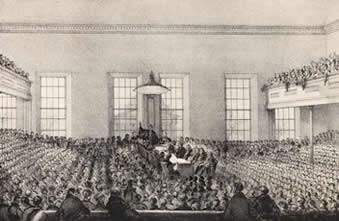 The first, entitled Turning the spotlight on the treasures of UCL Library Services is a project to develop a series of podcasts celebrating the treasures of UCL Library Services' Special Collections. A video podcast featuring an overview of the collections and how they are already being used in teaching and research has recently been made, as well as a series of twelve audio podcasts in which a number of UCL members of staff enthuse about why UCL Library Special Collections are important in their own field of study. Together, these podcasts will serve as an exciting and innovative marketing tool highlighting the vast range, uniqueness and importance of our Special Collections.
The first, entitled Turning the spotlight on the treasures of UCL Library Services is a project to develop a series of podcasts celebrating the treasures of UCL Library Services' Special Collections. A video podcast featuring an overview of the collections and how they are already being used in teaching and research has recently been made, as well as a series of twelve audio podcasts in which a number of UCL members of staff enthuse about why UCL Library Special Collections are important in their own field of study. Together, these podcasts will serve as an exciting and innovative marketing tool highlighting the vast range, uniqueness and importance of our Special Collections.
The video, which is just under ten minutes in duration, is an introduction to the range and extent of the collections, and includes comments from students. The shorter audio podcasts are based around particular collections or particular themes within collections, ranging from Art and Architecture to Sciences and Social History. Interviews were recorded over a period of time with a number of eminent UCL academics, including Professors Steve Jones, John Sutherland, Susan Irvine, David Price, Rosemary Ashton and Adrian Forty, as well as a number of Library Staff, discussing the importance of specific collections, both to UCL and the broader research community. All those involved were asked to select items and to talk about them in great detail, the result being a fascinating insight into the collections at close hand. Other scenes show groups of UCL undergraduates handling manuscripts as primary source materials to enhance their learning experience, and groups of local schoolchildren using themed study packs specially developed to support the National Curriculum.
The podcasts will be distributed via our website and the UCL iTunesU service and will act as important advertisements for the collections to reach a wider audience. As well as being accessible online at any time, the podcasts will be used in a variety of promotional activities being planned. For instance, the podcasts will be included in a series of Special Collections roadshows and presentations to Faculty meetings and other appopriate events and group gatherings. They will also be used in the Outreach and Public Engagement activities focusing on UCL Special Collections.
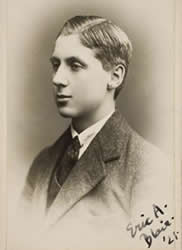 George Orwell, aged 18
George Orwell, aged 18
The aim of the second project, entitled Orwell Online: Digitisation of the George Orwell Archive, is to digitise George Orwell's political and domestic diaries, literary and general notebooks, and Spanish Civil War papers. The George Orwell Archive at UCL is the most comprehensive body of research material relating to the author George Orwell (Eric Blair) (1903-1950) anywhere in the world and UCL is considered as the international centre for studies on the author. Manuscripts, notebooks and personalia of George Orwell are a unique resource presented in 1960 on permanent loan by his widow on behalf of the George Orwell Archive Trust.
The creation of a digitised version of the material will significantly enhance accessibility to this resource for teaching, learning and research as well as promotional activities. The resulting digital files will be be deposited in UCL Library Services' Digital Collections Service and a range of supporting materials will be created such as online resource packs. In addition a podcast comprising a commentary and interviews with Orwell scholars discussing the importance of the collection to UCL and the wider community will be made available via UCL iTunesU.
As part of the fundraising programme necessary to sustain the Orwell Archive Digitisation Project, two exciting theatre events took place at UCL, instigated by a former alumnus of UCL, the actor and theatre company manager, Ryan Kiggell. On two consecutive nights in November 2009 the Aya Theatre company staged readings from Orwell's Burmese Days, which raised £1,110 towards the project. Various promotional activities accompanied the events, including audio podcasts delivered via UCL iTunesU. The events drew a good deal of publicity and there are plans to use this innovative method more widely in the future.
by Anne Chesher & Gill Furlong
Spotlight on… UCL Institute of Neurology, Rockefeller Medical Library
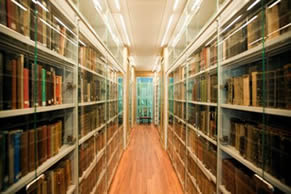 Institute of Neurology Archives & Rare Books Pod
Institute of Neurology Archives & Rare Books Pod
The Rockefeller Medical Library can be found at Queen Square, at the UCL Institute of Neurology and the National Hospital for Neurology and Neurosurgery. The Library contains a highly specialised collection covering neurology, neurosurgery and the neurosciences and provides a range of services and resources to all within UCL, UCLH and a number of NHS Trusts. As a national specialist collection the Library is also open for reference to, and is actively used by, visitors from all over London, the UK and Internationally.
The Library has recently been completely remodelled and refurbished, incorporating innovate and exciting new features. The project, christened the "Future Library Project", was initiated some three years ago and had as its aim a radical overhaul of the Library space. The Librarian, in conjunction with Library staff and Library users, drew up a list of requirements using as the starting points "gaps" and "opportunities".
Known gaps included a lack of local hands-on IT training facilities, too few public computers and reader spaces, a long discussed need for a home for the extensive National Hospital archives collections and for a small museum, lack of funds to digitise and catalogue the archives, inadequate space for Library staff (hot-desking had been necessary for several years), and there being limited places to showcase the work being carried out at Queen Square.
The chief opportunity was to take advantage of a gradual shift from print, to electronic access to journals, which was making it increasingly possible to store print more efficiently and in less high priority space.
Architects were asked to draw up a sketch plan and a costing. The very first draft plan achieved almost all of the aims and objectives, and a truly innovative whilst still very functional and welcoming Library space. This was fine-tuned with the expert help of many colleagues at the Institute, in UCL Estates, and in UCL Library Services.
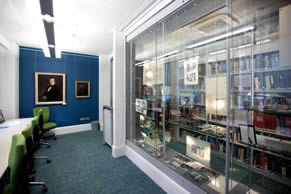 Institute of Neurology Training Room and Museum
Institute of Neurology Training Room and Museum
With the active support of key staff at Queen Square, the Brain Research Trust, and the National Hospital Development Foundation (two charities who provide invaluable support for the activities of the Institute and Hospital) agreed to fund the project. The Library is tremendously grateful to the Trustees and fundraising staff of these two charities for their support and hard work, and to all those who lobbied on the Library's behalf.
The building work took six months and the Library re-opened in June, time to play a full part in the celebration of the 150th anniversary of the National Hospital. All of the original aims and objectives have been achieved on time and on budget. The Library now has more reader spaces, more public computers and more space for staff. As well as greatly improved facilities for Library visitors, also now located within the Library are a museum, a training room, new facilities for storage and consultation of the archives and a new place for exhibitions and to showcase the work of Queen Square.
It has been hard work for the Library staff and everyone else involved, but the end results are proving to be tremendously popular with visitors to the Library. The first ever museum exhibition has been launched; popular with staff, patients, local history groups and other visitors. A very successful new information skills training programme utilising the new training facilities has also now been launcged, and the Library is now a very attractive and comfortable place in which to work and study.
by Louise Shepherd
The William Margulies Yiddish Collection in UCL's Main Library
It is perhaps not sufficiently appreciated that UCL Library has the exceptional fortune to house a quite remarkable collection of Yiddish materials that is not only incomparably richer than the Yiddish holdings of any other institution in the UK, but is also one of the best Yiddish collections in Europe. As it is now some twenty years since this collection came into existence this is an appropriate moment to take stock.
Yiddish as a modern academic discipline was first introduced at the University of Hamburg in 1922 by Dr Salomon A. Birnbaum (1891-1989). In 1933 he fled to the UK to escape Nazi persecution and taught Yiddish at SSEES as well as Hebrew Palaeography at SOAS till the late 1950s. For over thirty years following Birnbaum's retirement, Yiddish was not taught at London University. Meanwhile, however, from 1978 until 1987 Yiddish became an option in the Department of Germanic Studies at Queen's University Belfast and in the mid 1980s the subject began to be studied at Oxford. Several years later in 1989, the then Head of the Department of Hebrew and Jewish Studies at UCL, Prof. Mark Geller, invited the writer of these lines to reintroduce Yiddish at UCL.
As the teaching of the discipline began to establish itself, the inadequacy of the exiguous Yiddish holdings in the UCL Library (amounting at that time to less than thirty titles) made itself keenly felt. Already in 1990 some modest acquisitions were made to fill the most immediate needs and the situation was somewhat alleviated when the Librarian of Queen's University allowed their Yiddish holdings to be transferred to UCL. Purchases of out-of-print materials from the National Yiddish Book Center in Amherst, MA, had just got under way when in May 1991 the NYBC began offering what amounted to basic start-up collections of approximately 1,000 volumes to selected institutions. It was at this juncture that Mr. William Margulies offered generous financial assistance for the development of the Yiddish library resources at UCL. A retired publisher and businessman, Mr Margulies has throughout his life been a strong advocate of all aspects of Yiddish culture. With his help we also acquired large numbers of volumes from antiquarian booksellers in Stamford Hill and other Jewish neighbourhoods. Such was his enthusiasm, I vividly recall, that on one occasion he personally helped pack and carry heavy packages for delivery to the Library. Nor did his assistance stop there. From that time until the present day his support has continued unstintingly, enabling us to create and progressively expand what from 1992 became known as the William Margulies Yiddish Library, an independently housed entity within the Jewish Studies holdings of UCL Library.
At the time of the Institute of Jewish Studies conference on Isaac Bashevis Singer in March 1993 Mr Margulies inaugurated an endowment which not only secured the future development of the WMYL, but also established the Ben-Zion Margulies Lecturership in Yiddish Studies, a full-time post named in honour of Mr Margulies's late father. After my own retirement in 2002 Dr Helen Beer was appointed to this position and under her guidance the subject has continued to attract growing numbers of undergraduate and postgraduate students.
During the two decades since the establishment of the WMYL we have been able to acquire more or less everything that has appeared world-wide in Yiddish, on Yiddish or translated from or into Yiddish. Not only that, but, as has already been mentioned, we have been able to purchase many earlier relevant works from antiquarian sources. However, clearly our biggest disadvantage is quite simply that we started too late. It is extremely difficult for a library to make up for lost time. The best remedy for this deficiency is to acquire materials on microfilm or microfiche.
![Mendele Moykher-Sforim, Dos vintsh-fingerl [The Wishing Ring]](/library/Newsletter/img/denman-mendele.jpg) Mendele Moykher-Sforim, Dos vintsh-fingerl [The Wishing Ring], first edition, title-page, Warsaw, 1865, effectively the beginning of modern Yiddish literature, item A,M8 in Clearwater 'Three Classical Authors' microfiche series
Mendele Moykher-Sforim, Dos vintsh-fingerl [The Wishing Ring], first edition, title-page, Warsaw, 1865, effectively the beginning of modern Yiddish literature, item A,M8 in Clearwater 'Three Classical Authors' microfiche series
Three years ago Mr Margulies enabled us to acquire the Clearwater collection consisting of almost 2000 microfiches and 33 microfilm reels that had been assembled under the direction of the late Prof. Khone Shmeruk in 1980 and represent possibly the most important filmed collection of Yiddish source materials in existence. No single library in the world holds copies of all the materials that comprise this collection recorded at the YIVO Institute for Jewish Research in New York, the Hebraica section of the Library of Congress, the Hollis Library at Harvard University, the Jewish Theological Seminary also in New York, the National and University Library in Jerusalem and even in the private library of the Lubavitsher Rebe.
The first of the three sections of this collection is devoted to the three so-called classical authors, that is to say, Mendele Moykher-Sforim, Sholem-Aleykhem and Y.-L. Perets - not by any means the earliest of Yiddish writers, but those who in the late nineteenth century together established Yiddish literature as a European literature on a par with other major contemporary literary traditions. Of course, three such well-known authors were already well represented in the WMYL with numerous hard-back volumes and many so-called complete-works editions. But it is unfortunately characteristic of Yiddish Literature that for reasons intimately connected with the vicissitudes of the Diaspora and the Holocaust its publishing history has been exceptionally fragmented, obliging the scholar to look beyond familiar popular editions. It is furthermore axiomatic of literary studies in general that is never adequate to rely on the most recent version. Recourse is needed to the first edition and sometimes intermediate editions so as to trace the Entstehungsgeschichte of the work in question.
The second section in the microfiche collection consists of Yiddish children's literature and school texts. Although Yiddish literature is more than five hundred years old, Yiddish children's literature is a relatively recent phenomenon. It was the outcome of the modernisation and secularisation that Jewish life in Eastern Europe underwent from the end of the nineteenth century onwards - the same process in essence which produced modern secular literature itself. Moreover, the development of Yiddish children's literature was closely linked to the Yiddish school movement which endeavoured to establish schools providing modern education in Yiddish, the native language of its pupils. Examining these works one is immediately struck by beautifully produced natural science text books and other works inspired by what was then the most modern pedagogic methodology. The natural science titles make one keenly aware that while these days we go to Yiddish sources primarily in order to study Yiddish belles lettres and Ashkenazic history, we thereby run the risk of forgetting the breadth of the culture which particularly in the inter-war years covered just about every branch of knowledge. It is rewarding to realise what a high proportion of the most important Yiddish authors contributed to this genre and to note how, just as in the field of literature written for adults, virtually all internationally famous children's authors were made available to Jewish children in Yiddish translation. Here for example we will find works by Hans Andersen, Wilhelm Busch, Anton Chekhov, Charles Dickens, Anatole France, the brothers Grimm, E.T.A. Hoffmann, Victor Hugo, Rudyard Kipling, Jules Verne, H.G. Wells, Oscar Wilde, etc.
The third section is made up of Yiddish displaced persons' periodicals published during the years 1945-1949 in the DP camps set up by UNRRA often at the same locations where the Nazis had been murdering millions only months before. It represents an astonishing document to the spiritual resilience of many of the survivors from the camps and of the refugees who later joined them from further East. It is quite amazing to see how cultural life was renewed among these desperate survivors of so much torment and grief. Fortunately, a considerable proportion of these materials has survived as the result of having been sent to YIVO in New York by American Army Jewish chaplains and diverse volunteers. This collection certainly supplements in a very important way our holdings in the field of Holocaust Studies and affords a very special perspective on these horrifying events.
![Perets Hirshbeyn, A mayse mit a ber [A Tale of a Bear]](/library/Newsletter/img/denman-perets.jpg) Perets Hirshbeyn, A mayse mit a ber [A Tale of a Bear], with illustrations by Boris Aronson, New York, 1925, item 343 in Clearwater 'Yiddish Children's Literature' microfiche series, pp. 11-12.
Perets Hirshbeyn, A mayse mit a ber [A Tale of a Bear], with illustrations by Boris Aronson, New York, 1925, item 343 in Clearwater 'Yiddish Children's Literature' microfiche series, pp. 11-12.
Of course, we are not resting on our laurels and with the help of Mr Margulies's munificence we are continuing to add new titles to the WMYL on an almost daily basis. We hope furthermore to be able in the future to acquire additional microfilm materials that will go towards filling the lacunae occasioned by the comparatively late foundation of the collection.
The only other surviving Yiddish collections in Europe that can compare in size with the WMYL are the much older and somewhat larger Medem and Vernadskij libraries located in Paris and Kiev respectively which escaped the barbarous depredations of Hitler and Stalin by a combination of remarkable good luck and the dedication of courageous individuals (but that is another story). All three libraries, the Medem, the Vernadskij and the WMYL, have their relative strengths. The Medem is particularly rich in world literature translated into Yiddish, the Vernadskij, as one would expect, excels in its rich holdings of Yiddish materials published in Russia and the Soviet Union. The WMYL is particularly strong in modern literary and linguistic scholarship.
It is important to mention that the WMYL is to some extent complemented by the holdings of the British Library and SOAS, both within walking distance of UCL, and by the Taylorian Institution in Oxford and the Muller Library at Yarnton Manor (belonging to the Oxford Centre for Hebrew and Jewish Studies), but especially by the unique collections of early Yiddish manuscripts dating from the sixteenth century held by the Bodleian Library in Oxford and by the library of Trinity College, Cambridge.
It should not be necessary in this context to stress the importance and richness of Yiddish literature, though sadly this is not always realised. The existence of the WMYL at UCL certainly provides compelling evidence of the major significance of the Yiddish contribution to European literary culture. The approximately 7,000 books and the microfilm materials that complement them document the rise of Yiddish devotional and secular literature in Germany and northern Italy in the late mediaeval and renaissance eras, the impact on Jewish literary culture in central and eastern Europe in the eighteenth and early nineteenth centuries of both Enlightenment thinking on the one hand and the ḥasidic or pietistic reform movement on the other. In the late nineteenth century (at a time, that is, only slightly later than for instance the rise of modern Russian literature) a remarkable efflorescence of modern writing took place closely associated with the names of the three "classical" authors to whom we have already referred which in turn led to an exponential growth of literary creativity centred principally in Warsaw, Moscow, Kiev, Odessa, Berlin and New York, but also in many other locations. Here hundreds of talented poets, novelists and playwrights who were keenly aware of comparable developments in Russian, Polish, German, French and, at a somewhat later date, English literature wrote highly significant works most of which are now to be found in the WMYL both in the original Yiddish and in translation. Best known perhaps to the general reader are the works of the much-translated Sholem-Aleykhem, Sholem Ash and the Nobel-prize-winner Isaac Bashevis Singer (or Yitskhok Bashevis), but Yiddish literature may in all fairness be said to teem with superb works by many authors, far too numerous to name, of equal or arguably superior genius.
The WMYL then constitutes not only an invaluable resource for students of Yiddish at UCL, but a centre of excellence for researchers from far and wide in which we may all take grateful pride.
by Hugh Denman
 Top of page Top of page
Issue 26 - Autumn term, 2010
|

